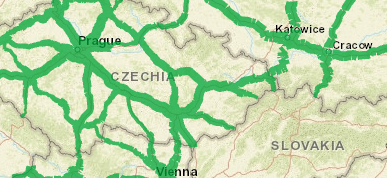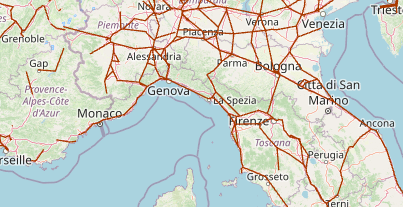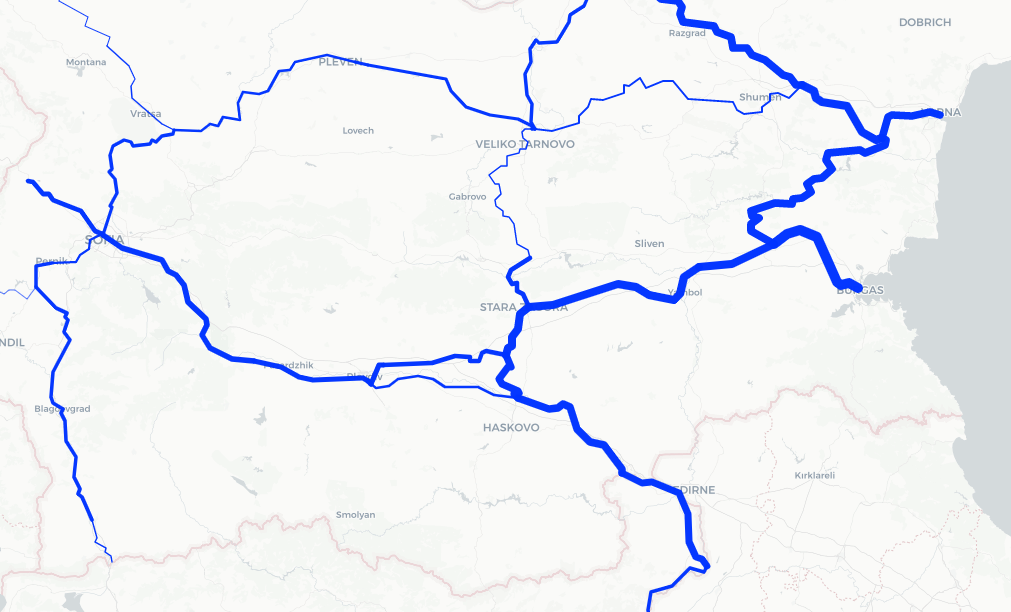Page History
...
E-Roads of the AGR Network – E-Roads are defined in the 1975 European Agreement on Main International Traffic Arteries (AGR). https://unece.org/DAM/trans/doc/2016/sc1/ECE-TRANS-SC1-2016-03-Rev1e.pdf. See a map of the network here https://unece.org/DAM/trans/conventn/MapAGR2007.pdf.
E-Rail lines of the AGC Network – E-Rail lines are defined in the European Agreement on Main International Railway Lines of 1985 (AGC), https://unece.org/DAM/trans/doc/2019/sc2/ECE-TRANS-63-Rev.4e.pdf.
E-Inland Waterways of the AGN Network – E-Inland Waterways are defined in the European Agreement on Main Inland Waterweays of International Importance (AGN) https://unece.org/texts-and-status. Explore the network (including in map form) in the Blue Book database here https://apps.unece.org/AGN/.
NUTS classification – regions are classified according to the Nomenclature of Units for Territorial Statistics (NUTS). The NUTS serves as a reference for the collection, development and harmonisation of EU regional statistics and for socio-economic analyses of the regions (more information is available on Eurostat's website: http://ec.europa.eu/eurostat/web/nuts/overview). Several Eurostat datasets are based on movements between NUTS2 regions.
...
In order to allow reproducibility, open-sources source statistical and geospatial software was used for all analyses, namely R (utilising RStudio) and QGIS. The R script files used for production of any maps below are either linked to below or are available on request. The scripts are written in a way that should allow any user to run them and recreate the same maps. If a user is new to R, then each library referenced at the start of each script will need to be installed (only once). E.g.
install.Packagespackages("tidyverse").
UNECE E-Road and E-Rail Censuses
...
The UNECE E-Road Census collects traffic volumes on principal road arteries of international importance. Data are only collected every five years. Data for 2020, 2015 2010 and 2005 can be explored here https://www.unece.org/trans/main/wp6/e-roads_maps.html. Unfortunately only a limited number of UNECE countries provide data in a geospatial format that allows this visualization. Some countries do have traffic counts at specific points and the secretariat is exploring ways to help countries produce similar outputs with these traffic counts as inputs (for example, taking the traffic count and the coordinates of the counting post and projecting it onto a small segment of the network).
The E-Road census asks for both total AADT and the specific AADT for heavy vehicles (vehicle categories C+D, including both buses and coaches, and heavy good vehicles). This allows heavy vehicles to be used as a reasonable proxy for goods traffic.
E-Rail Census
The UNECE E-Rail census collects data on principal rail routes, as defined by the AGC, in a similar fashion to the E-Road census. Rail traffic has the advantage of the split between passenger and freight trains is normally easy to make, therefore traffic for either the movement of people or goods can be visualised separately. FOrt Eurostat countries, these data come from Annex V of the rail regulation (previously Annex g).
Due to the way the data are collected, Shapefiles that model the real shape of the network are typically not available, but origin-destination lines can be created. Depending on how well segmented the data are, these can often fit the realities of the country's geography quite well. Explore the data here https://www.unece.org/trans/areas-of-work/transport-statistics/statistics-and-data-online/e-rail-census/traffic-census-map.html.
The secretariat has tried to map these straight lines onto the real network. As no Shapefiles currently exist of the AGC network, the European TEN-T core network was used instead. The preliminary results for goods trains can be explored at https://rpubs.com/BlackburnStat/ERAIL_Goods.
Eurostat Regional (NUTS 2 and NUTS 3) Data for Road, Rail and Inland Water
In addition to the census data collected directly by UNECE, Eurostat collects many different regional datasets that can be visualised, some of which are on an annual basis. While the UNECE censuses collect traffic volumes, i.e. number of vehicles per day, the Eurostat data focus on transport measurement, that is passenger numbers and passenger-km, tonnes and tonne-km. Examples of possible visualisations are are shown below.
Rail Passengers
There is only one Eurostat passenger rail dataset that contains data below the national level. The "tran_r_rapa" set covers both national and international railway passengers transported by loading and unloading NUTS 2 region.
...


